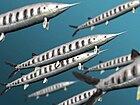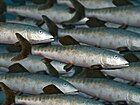Gwawinapterus
| Gwawinapterus Temporal range:Late Cretaceous,
| |
|---|---|
| Scientific classification | |
| Domain: | Eukaryota |
| Kingdom: | Animalia |
| Phylum: | Chordata |
| Class: | Actinopterygii |
| Order: | †Ichthyodectiformes |
| Family: | †Saurodontidae |
| Genus: | †Gwawinapterus Arbour &Currie,2011 |
| Species: | †G. beardi
|
| Binomial name | |
| †Gwawinapterus beardi Arbour & Currie, 2011
| |
Gwawinapterus beardiis aspeciesofsaurodontidichthyodectiformfish from theLate Cretaceousperiod ofBritish Columbia,Canada.While initially described as a very late-surviving member of thepterosaurfamilyIstiodactylidae,further examination has cast doubt on the identification of the specimen as a pterosaur, and research published in 2012 identified the remains as having come from asaurodontidfish.
Description
[edit]Gwawinapterus beardiis known from a single fossil specimen, consisting only of the front half of a skull (upper and lower jaws). The tip of the snout is rounded and deep with a height of about 9.5 centimetres (3.7 in). The tip is about 6.5 centimetres (2.6 in) from the front edge of the largest skull opening, orfenestra.Below this opening the upper jaw is about 21 millimetres (0.83 in) tall. The jaw was originally suggested to be a sutureless fusion of thepremaxillaandmaxillaof a reptile. Each upper jaw holds at least 26 teeth, eleven or twelve of them below the fenestra; the front of the tooth row has not been preserved and the fossil is broken at its end. The teeth are closely packed. The tooth crowns are small, 4 millimetres (0.16 in) tall and 2.75 millimetres (0.108 in) wide, flattened, and triangular with slightly curved edges. The edges are not serrated, but rounded. The teeth are very straight, showing no curvature to either the back or the middle. The more narrow single tooth roots are relatively long, about 10 to 12 millimetres (0.39 to 0.47 in), for a total tooth length of about 14 millimetres (0.55 in).[1]
The describers have identified two uniquederivedfeatures (autapomorphies): a number of more than 25 teeth in the upper jaw and a tooth root more than twice as long as the crown.[1]
Discovery and identification
[edit]In May 2005, amateur paleontologist Sharon Hubbard found a rock with bones and teeth visible on the surface on a beach nearCollishaw PointatHornby Island,British Columbia,Canada.Accompanying her was Graham Beard, the President of theVancouver Island Paleontology Museum SocietyatQualicum Beach,who added the fossil to its collection. Beard brought the find to the attention of paleontologistPhilip J. Currie.He in turn obtained the help of colleagueVictoria M. Arbourwho identified the specimen as a pterosaur new to science.
In2011,Arbour andPhilip J. Curriedescribed the specimen as thetype speciesofGwawinapterus beardi.The generic name is derived fromGwa’wina,meaning "raven"inKwak'wala,the language of theKwakwaka'wakw,in reference to the similarity of the skull with the stylised raven heads of the hamatsa masks of that tribe, and a Latinised Greekpteron,"wing". Thespecific namehonours Beard.[1]
The rock was sawn in two for better study and its halves, with inventory numbers VIPM 1513a and VIPM 1513b, represent theholotype.It probably originated in marine layers of theNorthumberland Formationdating to the lateCampanianstage, from about seventy million years ago.[1]
The rock, acalcitenodule, has a length of about 20 centimetres (7.9 in). It holds the snout of the specimen, initially identified as the first pterosaur skull material found in Canada. Some of the surface of the bone is visible; partly it has been preserved as a cross-section or as an imprint. Erupted tooth crowns have disappeared but tooth sockets are still present and due to breakage tooth roots and replacement teeth are visible.[1]
Gwawinapteruswas assigned to theIstiodactylidae,using the method ofcomparative anatomy.By comparison with the skull of the istiodactylidIstiodactylus sinensis,thewingspanofGwawinapterushas been estimated at three metres.[1]The authors noted that as a pterosaur, it would be the youngest known istiodactylid specimen by forty million years and the only known toothed pterosaur from the Late Cretaceous. This would imply that pterosaur variation had declined less than previously presumed during the Cretaceous period.[1]
However, subsequent research cast doubt on the identification of the specimen as a pterosaur. In a 2012 study of istiodactylid skulls, Mark Witton noted that theGwawinapterusskull showed a highly unusual pattern of tooth replacement, with new replacement teeth growing directly over older teeth. This aspect of its biology is otherwise unknown in any pterosaur. Witton stated that this "fundamental distinction questions the pterosaurian nature ofGwawinapterus,and may indicate that istiodactylids remain a group exclusively known from the Lower Cretaceous. "[2]A more thorough re-examination of the specimen, published in 2012, suggested that the specimen was in fact not a pterosaur but came from a species ofsaurodontidfish.[3]
See also
[edit]References
[edit]- ^abcdefgArbour, Victoria M. & Philip J. Currie (2011)."An istiodactylid pterosaur from the Upper Cretaceous Nanaimo Group, Hornby Island, British Columbia, Canada".Canadian Journal of Earth Sciences.48(1): 63–69.Bibcode:2011CaJES..48...63S.doi:10.1139/E10-083.
- ^Witton, Mark P. (2012)."New insights into the skull ofIstiodactylus latidens(Ornithocheiroidea, Pterodactyloidea) ".PLoS ONE.7(3): e33170.doi:10.1371/journal.pone.0033170.
- ^Vullo, Romain; Buffetaut, Eric & Everhart, Michael J. (2012). "Reappraisal ofGwawinapterus beardifrom the Late Cretaceous of Canada: a saurodontid fish, not a pterosaur ".Journal of Vertebrate Paleontology.32(5): 1198–1201.doi:10.1080/02724634.2012.681078.







